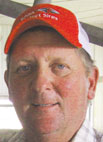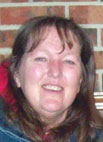 Steve Stamate remembers when Everton, Mo., was a thriving little town in eastern Dade County.
Steve Stamate remembers when Everton, Mo., was a thriving little town in eastern Dade County.
“I hauled milk in 10-gallon cans when I was in high school.” Steve recalls going to the cheese plant in Greenfield; just one of many local businesses no longer around.
But what goes around, comes around.
Steve began his first short-lived dairy career at the age of 24.
Since then he’s done a little bit of everything. “I’ve raised hogs. I’ve hauled walnuts, done custom seed cutting. I’ve milked for other people, cut hay.”
“I’ve always known I wanted to farm. Everybody told me you can’t do it. Everybody thinks you have to inherit a big farm. People say you can’t make it farming.”
Steve returned to the area of his family farm in 1990; a farm that had been in his family since it’s purchase in 1866. Steve is quite the historian and storyteller with tales of trails from Sarcoxie to Ft. Scott and many points all over southwest Missouri.
He and his wife Kathy bought a small old farmhouse with no indoor plumbing on two acres that was part of the original family farm. “And it kind of snowballed from there.”
Kind of is an understatement. Over the next few years, Steve began renting pasture, and before long was up to 20 different landlords, renting more than 5,700 acres and running 1,100 or more cows.
This round was about beef. But Steve tired of the constant driving from pasture to pasture every day and responding to the many well-meaning calls “wondering if those cows out, were his?’
“Everybody else quits dairy and goes into beef. I quit beef to go into dairy,” Steve described the turning point in his life. Just three years ago September.
Steve and Kathy now sit on 346 acres they own and they lease another 721.
In those three short years Steve has built a milking parlor for 24 cows (12-per-side) which can be handled by one person, “but you can’t goof off,” Steve warned. There are two miles of underground water-pipe, irrigation lines, two lagoons, a well – all from what started as just pasture with no fences.
“We are in the middle,” Steve described his current operation, “as the whole idea of grazing dairy cows is that they should only have to walk a quarter mile in any direction.”
Steve’s goal is to become a fall-seasonal grass dairy. He’s been studying the New Zealand methods.
The schedule he’d like would go something like this: “I’d calve between September and November – get it all done in 60 days. Get the calves raised and weaned, graze grass in spring. You still have a lot of cows to milk but you have a life. Not calving in the spring or breaking heifers to the barn. Then in mid-July, bang, turn ‘em all dry. Don’t milk until mid-September. Clean the barn and take a vacation.”
That vacation might include visits to cemeteries. Kathy recently published a baby name book, “Need a Name?” which lists more than 2,600 unusual names copied off headstones. All the names come from the years 1800-1930.
Steve bucks the traditional dairy model in another way. He AIs with a milking shorthorn bull with his Holstein/Jersey cross cows. “You get the quantity from the Holstein, butter-fat from the Jersey and the shorthorn keeps the size down.”
Steve is milking 117 now but should be up to 300 by November.
Steve noted that his loans won’t be paid off until he reaches his 80s but he’d like to find a young couple to come in that would like to dairy but can’t find a way to start.
“If they were willing to provide all the labor, they could get 25 percent of the milk check. Then they could save and start buying cows. I’d hate to sell but I might give somebody a lifetime lease. Most people don’t go into dairying unless your family is already in it. By the time you get the money, you are too smart to do it,” he smiled.







